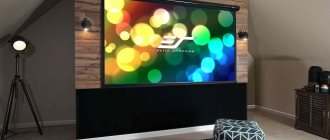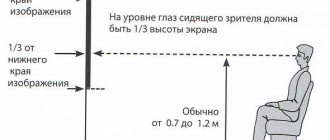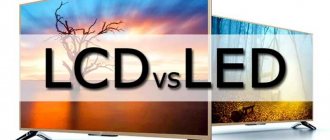One of the most important parameters that you need to pay attention to when buying a TV panel is the screen resolution. The quality of the picture largely depends on it. In addition, this indicator is responsible for eye strain when watching TV shows. That is why many users, before purchasing equipment, want to know what is the best screen resolution for their TV. To answer this question, you should familiarize yourself with the definition of this term and its dependence on factors such as the type of display, the distance between the television receiver and the planned viewing location, the purpose of primary use and other criteria.
What does screen resolution affect?
Resolution is the number of dots (pixels) from which a picture is created on a television screen . At first glance, it seems that the image on the television receiver is solid, but if you come very close and look closely, you can see that it consists of dots located close to each other. These points (aka pixels) are arranged in a grid. The more there are, the clearer and more detailed the picture is.
To get maximum viewing pleasure, you need to take care of the appropriate format of the content displayed on the display. But when choosing a resolution, you should not be guided only by a large number of pixels. The distance to the television panel must also be taken into account.
On a note! If the user is far from the TV receiver, he will not notice how clear and detailed the image is, which means he will not fully enjoy the quality of the video. At the same time, sitting too close, a person will see not the whole picture, but individual pixels, which will create a significant strain on the eyes and will also not allow them to enjoy the events on the screen.
Screen resolution is measured horizontally and vertically. Thus, the value 1920x1080 indicates that there are 1920 pixels horizontally and 1080 pixels vertically. Modern TVs have different resolution standards.
TV screen resolution
The main characteristic of modern screen matrices is resolution. What it is?
Definition
The matrix resolution of a TV or monitor screen is the number of pixels that make up the device. The higher the value, the better the image.
The resolution specification applies to all devices that have a screen for playing multimedia files: smartphones, tablets, e-readers, laptops, etc.
Resolution value
The higher the value of this parameter for the device’s matrix, the denser the pixel grid is, respectively, the better and higher quality the displayed image, the higher the sharpness, clarity and color rendition.
Pixels are specific points that are arranged in a specific order according to the structural diagram specified by the manufacturer.
Often, when choosing a new device, users do not pay attention to this parameter, looking only at the diagonal of the TV. It should be remembered that a large diagonal does not guarantee a high value of this parameter; therefore, when buying a TV, you need to pay attention to all the characteristics. It happens that small devices have built-in higher quality matrices that can produce an excellent picture.
However, when viewing multimedia files, you should remember that a high TV resolution alone does not guarantee a good image. To obtain a high-quality picture, playback of high-quality multimedia files is required.
The scan type is also one of the most significant aspects of a good image. Currently, progressive scan technology is widely used in all modern monitor models, guaranteeing high clarity and smoothness when playing multimedia files.
An outdated type are matrices using interlaced scanning technology, which can cause image flickering.
Resolution Standards
At the end of 2021, the following standards are relevant:
- HD;
- Full HD;
- Ultra HD (4K).
On a note! In 2021, test broadcasting was successfully carried out in the new 8K format. However, mass production of such televisions has not yet begun, although the first models have already been released. Commercial broadcasting in this resolution has already started in Japan in 2021.
HD or HD Ready resolution with 1366x768 pixels is used in budget television receivers. Such devices are well suited for viewing broadcast and some digital channels, where most programs are broadcast in this format.
Full HD resolution (1920x1080) is used to watch movies in high quality. Thanks to this pixel density, high detail and a very clear picture are ensured. The image quality of Full HD television panels is much better than that of HD devices.
The next technological step is Ultra HD or 4K resolution (3840x2160). When buying a TV, this format is the best solution possible at the end of 2021. Equipment with Ultra HD resolution is found only in large diagonals (40 inches and above), but to see the maximum visual effect of the broadcast video, a screen size of 55 inches or more is required.
The 8K format (7680x4320) should replace 4K resolution in the near future. The first device was released by Sharp. Today, TVs with this screen format are produced in minimal quantities, which is explained by the lack of content for them (at the moment) and the very high cost.
Types of TV resolutions
Currently, the gradation of these parameters is strictly defined and is the same for all manufacturers of household appliances. Let's consider how these indicators influence the purchase of products.
640×480
The lowest screen resolution in modern devices. A technology with this indicator is probably only suitable for watching terrestrial television on a small diagonal.
1280×720
High quality format (HD). Devices with this value are able to reproduce a fairly clear picture. They are suitable for watching TV shows and various multimedia files on relatively small monitor diagonals.
1920×1080
The so-called Full HD format. The image on TVs of this type is truly high-quality, allowing you to choose devices with a large diagonal. TVs with this resolution value are the most common on the market nowadays.
2560×1440
QHD technology. Another name is possible - 2K. The pixel density is exactly 4 times higher than HD, which allows you to achieve excellent image quality.
3840×2160
The so-called 4K or Ultra HD image format. Currently, this format has become widespread, however, devices with it are still quite expensive, which does not make it possible to make them available to all segments of the population. The picture on such screens turns out to be very realistic, as close as possible to the natural image.
Nowadays, 8K and higher technologies are being introduced into TVs, however, such devices are too expensive and inaccessible. In addition, there is currently not enough multimedia content in this resolution, which makes the purchase unjustified.
When choosing a TV, take into account all the parameters. Remember that the screen resolution plays an important role in obtaining a truly high-quality image. But in any case, it is best to evaluate the image quality with your own eyes.
TV
Resolution by TV type
Types of television receivers differ in the different technologies used to transmit images, so they are characterized by different screen resolutions. Thus, outdated CRT devices have very weak characteristics compared to LCD and LED TVs.
Resolution of CRT television receivers
Cathode ray television receivers have a screen resolution of only 640x480. These inexpensive devices were popular until the end of the 20th century, but are practically not produced today. They do not display the best picture, but such characteristics were sufficient for displaying analogue television channels. To watch TV programs, you only needed to purchase an over-the-air antenna and set up TV channels.
On a note! Due to the fact that by the end of 2021 the Government of the Russian Federation plans to completely switch to digital high-quality broadcasting, CRT television receivers are losing their relevance, but, nevertheless, continue to be used mainly by people of the older generation who do not have the opportunity to purchase more modern equipment.
Resolution of PR TV receivers
LCD and LED TVs today have HD, Full HD and 4K resolution. Liquid crystal (LCD) samples with HD format belong to the budget price segment, while medium-cost equipment broadcasts an image with a number of pixels of 1920x1080, and the most expensive samples are television panels with a 4K screen format.
Recommendations when choosing a resolution for TV
What is the best TV screen resolution? There are several recommendations that it is highly advisable to follow when choosing:
- It is not necessary in all cases to choose a TV with a large diagonal and a large number of pixels. It all depends on what purpose you are watching TV for. To watch cable TV and watch DVD video files, it is enough to choose the budget HD Ready standard. But if you need advanced features, such as watching satellite TV, choose Full HD. The benefits of this resolution include higher brightness, contrast and color accuracy. However, the cost of Full HD TVs is much higher;
- In some cases, the picture may be distorted when watching TV. In order not to make a mistake when choosing a resolution for TV, it is recommended to pay attention to the following features:
- To obtain information about display resolution, read the instructions and determine what technical parameters the product has. The data can be found both from the seller and on the manufacturer’s website;
- Please note that the image resolution corresponds to the lower TV resolution. So, when watching a DVD on the screen of a device that supports Full HD, the image will have exactly the DVD resolution;
- A very relevant question is which resolution is best for a TV. Today, the most technologically advanced standard is 4K (Ultra HD);
- If you want to purchase a modern TV with a high level of resolution, wide functionality, high-quality picture and sound, you should pay attention to models from well-known manufacturers: LG, Sony, Panasonic, Philips, Samsung, etc.;
- Most new TV models have a high enough resolution that they can be viewed from a distance of 1-1.5 m without losing the quality of the visible image. But in order to ensure the most comfortable viewing of TV, you also need to pay attention to the diagonal of the display.
Watch a video about screen resolution features
Which resolution is better
When choosing a TV based on the “screen resolution” parameter, it is worth considering several factors that determine the priority use of equipment. The most important criteria will be discussed below.
For DVD
If you purchase a TV for watching video from DVDs - in karaoke bars, in classrooms, in transport - you can choose a budget model with a low resolution. This is due to the fact that DVD recordings are in the 720x576 format, which means that even if the TV receiver has a significantly larger number of pixels, it will not be possible to change the image quality for the better.\
For digital television
If the HD format was sufficient for analogue TV channels, then with the advent of digital television models with a resolution of 1920x1080 become relevant. By purchasing such a television panel, the user will receive a clear, detailed picture and the pleasure of watching their favorite programs in excellent quality on the big screen.
For the Internet
If the TV receiver will be used to view content downloaded from the Internet, then everything depends on the resolution of the saved video. If it is low, a device with a 1366x768 format will be enough for the user. If you plan to watch movies in Full HD or 4K quality, then the television panel must have the appropriate resolution.
Depending on the distance
The distance from the screen to the viewing location should also be taken into account when choosing the resolution of the TV receiver. The optimal distance is 2.5 - 3 TV diagonals. But this statement is true for HD resolution. So, for a device with a diagonal of 32 inches (81 cm), the sofa or chair should be at a distance of 2.5 meters. From this distance, the picture is clearly visible, and the user will be able to enjoy viewing.
Advice! If you watch TV from a distance greater than the recommended distance, the image will be poorly visible and all the benefits of high resolution will be invisible. In this case, it is more advisable to choose a television receiver with a low indicator or a larger diagonal.
As the number of points increases, the recommended distance decreases. Basic distance requirements for safe viewing are shown in the table below.
Resolution selection
Most of the videos on the Internet are in HD or Full HD format.
To understand what the resolution of the TV screen should be, take into account the format of the content and the characteristics of the viewing room. TV panels are used not only for home screening of films. They are installed in driving schools, karaoke bars and other places.
Format selection:
- for viewing from discs. Here they rely on the quality of the recorded media files. Movies downloaded from the Internet can be of any quality - from SD to 4K. If you have a lot of old DVDs and want to watch them, then you don’t have to buy an expensive TV. A simple TV receiver with a small diagonal will be enough, because the movie parameters in this case are 720 x 576 pixels;
- for TV shows. Not so long ago, analog and digital standards were in use. The first ones have practically disappeared, and “digital” has taken its niche. For analogue broadcasting, a TV receiver with HD support, HD Ready (1366 x 768) is sufficient. The digital resolution requires more - from 1366 x 768 to 1920 x 1080. The broadcast image will be high-quality and detailed;
- for the Internet, games. Most of the videos on the network are in HD or Full HD format. This means that the television receiver must be able to reproduce them. For games, a resolution of 1920 x 1080 will be sufficient.
It is clear what the resolution of a TV screen is, but when choosing technology, they take into account the size of the room in which the viewer will watch films.
Here the distance from the display to the viewer plays a role. For HD quality, the optimal distance is 2.5 - 3 panel diagonals. For example, if the TV has a diagonal of 32 inches, it is placed 2.5 meters from the sofa or chair.
Many people unknowingly believe that the higher the resolution, the better. This is partly true, but there is too little Ultra HD content now. And if you watch, for example, a movie in HD quality on a 4K TV, the image will simply be stretched, which will have a bad effect on detail.
Many shows and movies are now broadcast in HD and Full HD. That is, a resolution of 1920 x 1080 is enough for most purposes. But, do not forget that technology is developing every day.
An equally important factor when buying a TV panel is the screen diagonal. Full and Ultra HD content looks good on large TVs, from 40 inches in size. For 4K, the optimal diagonal is 55 - 65 inches. For a small screen (up to 24”), there is no point in choosing a format “older” than HD - this will not improve the picture quality.
Scan frequency - as a component of resolution
In addition to screen resolution, the quality of the picture is seriously affected by the type of scanning, which can be interlaced (“i”) and progressive (“p”). This designation looks like this: 1080i or 1080p. In the case of the first type of scan, the image is updated twice a minute: the even lines change first, then the odd ones. The disadvantage of this type is the flickering effect that occurs when there is good lighting in a room with a significant content of ultraviolet rays.
Important! Progressive scan is better: it updates all rows at once every minute. Due to this, the picture quality has a positive effect.
The influence of screen resolution on image clarity
Of course, an important technical parameter of any screen is its size. The size of any screen is determined by its diagonal length in inches. However, the most important criteria for choosing a screen are, perhaps, the clarity and amount of information displayed on it. And really, who wants to look at a huge and blurry picture on the screen?
The clarity and amount of information displayed on the screen is primarily affected by its resolution. Resolution is determined by the number of indivisible physical elements that make up the screen. These elements are called pixels and can have different structures and sizes. You can find out the screen resolution using software installed on your electronic device. In general, the clarity of the image on the screen depends on the size of the screen pixels and the interpixel distance.
If we consider the dependence of clarity on pixel sizes, then we can definitely say that the smaller the pixel size the screen has, the clearer the image will be on it. If you take two screens that have the same diagonal lengths, but different pixel sizes, then the screen with the smaller pixel size will have a higher resolution. This case can be seen very well in the example of modern, so-called “HD” and “HD-ready” TVs. With equal diagonals, the first type of TV has a resolution of 1920x1080 pixels, and the second type has 1280x720 pixels. Of course, the picture displayed on the TV screens of the first type will be one and a half times clearer than the picture obtained on the TV screen of the second type. Interestingly, well-constructed marketing did its job, and “HD-ready” TVs at one time were very successful, although they did not show an “honest” HD picture. Another example is the screens of modern mobile smartphones. Even today, many people still mistakenly consider the diagonal size to be the main indicator of a device’s screen. But the sphere of portable devices these days is at a stage of rapid development, and often the screens of smartphones of two neighboring generations are completely different things. The screen of a five-inch smartphone released last year can have twice the pixel size compared to the screen of a new series smartphone. It is striking that the screen resolution of many modern phones exceeds the resolution of the screens of modern large TVs and monitors. This fact seems somewhat illogical even taking into account the fact that the user is looking at the phone screen from a much closer distance.
In addition, the clarity of the image on the screen depends on the distance between the pixels. If a decrease in pixel size is compensated by an increase in the interpixel interval, this will lead to a loss of image clarity on the screen. The enormous panel sizes of modern TVs are often achieved by increasing this spacing rather than the pixel size, which makes them unsuitable for use as monitors.
Review of manufacturers
In 2021, the model range of almost every manufacturer includes TVs with HD, Full HD and Ultra HD resolutions. This applies to both well-known brands (for example, Samsung, Sony, LG, Philips, etc.) and little-known brands.
Advice! With an equal number of pixels in devices from different manufacturers, other characteristics will also affect the clarity of the picture - brightness, color, matrix, etc., so it’s worth comparing by image quality in general, and not by pixel density.
Among brands that have the same resolution, lesser-known companies will have lower prices. Devices made by Sony will be the most expensive. Equipment from Samsung is sold a little cheaper. Approximately in the middle are TVs from LG and Philips. So, the table below shows TVs with Full HD resolution.
| Brand and model | Diagonal, in inches | Screen resolution | Cost, rub |
| Supra STV-LC40LT0010F | 40 | Full HD | 15690 |
| BBK 40LEX-5056/FT2C | 40 | Full HD | 16890 |
| Philips 40PFS4052 | 40 | Full HD | 21890 |
| LG 43LJ515V | 43 | Full HD | 22890 |
| Samsung 43N5000AU | 43 | Full HD | 24990 |
| Sony 40RE353 | 40 | Full HD | 27990 |
Supra STV-LC40LT0010F on Yandex Market
BBK 40LEX-5056/FT2C on Yandex Market Philips 40PFS4052 on Yandex Market LG 43LJ515V on Yandex Market Samsung 43N5000AU on Yandex Market Sony 40RE353 on Yandex Market The table shows prices for TV receiver models according to Yandex Market. The most budget devices of each brand were selected, without any additional options (Smart TV, Wi-Fi, etc.). LG and Samsung TV receivers are presented in 43-inch sizes, because... The 40-inch diagonal is not included in the model range.
So, in order to enjoy a high-quality picture using the maximum screen resolution capabilities, when choosing a TV you should take into account several factors that were given above. However, it is worth taking into account the speed of progress in this area, so that in a year or two the purchased model will also be relevant.
Which resolution is better to choose?
It is not necessary that a TV with a very large diagonal and a large number of pixels will allow you to get an ideal image. Taking into account the signal source, you can choose the best option to achieve the best effect.
- To view channels 1 and 2 of CETV multiplexes, most of the channels of satellite and cable providers without HD and UHD marks, DVD films, the capabilities of a TV panel with an HD Ready screen are sufficient.
- If you plan to watch HD digital television on your TV and use the TV screen together with a Blue-Ray player, then it is better to choose a Full HD panel.
- If your budget allows, and you also want to buy a TV that will not become outdated in the next 5 years, choose a model with a 4K matrix. The same standard is relevant for gamers - in 2021, most game consoles switched to UHD content.
Gaming on TV
Today, according to experts, models with Full HD screens are considered the best choice. When choosing, you should take into account other important parameters: screen diagonal, viewing angle, matrix type, scan type, and others.
What is the optimal screen resolution?
Screen parameters are the most important component when choosing a TV. First of all, this is the resolution of the matrix. The larger it is, the higher quality image you will get. If 5 years ago it was still possible to justify the purchase of a TV with HD resolution (1440x720) with approximately 30% cost savings, today Full-HD (1920x1080) panels have become the de facto standard, pushing HD TVs into archival models, and 4K TVs are still considered to luxury class.
In our opinion, for a 32-inch screen size, Full-HD resolution is optimal. Provided that the TV is usually watched at a distance of more than 2 m, you will definitely not be able to distinguish any pixels on the HD panel. However, for complete immersion in what is happening on the screen, especially when watching spectacular films, we recommend a Full-HD matrix and sitting no further than 1 meter from the screen. This means that only 1-2 people can comfortably fit in front of the screen, i.e. This TV size belongs to the “Egoist” category. Of course, you can watch TV shows at 2-3 meters with the whole family, but the cinema effect will already be there.
Equally important is the presence of a matte coating on the screen. It will slightly reduce the richness of the colors, but will eliminate the unpleasant effect of reflection of you and the lamps in the room.
This might be interesting:
- How to determine the optimal distance to the TV (+ table)
Advantages of 32-inch TVs
TV devices with small displays are popular among users for several reasons:
- Ease of viewing programs;
- Compatible with the space of a small apartment or bedroom of 20 square meters;
- Placed in the room of a teenager or a person of retirement age;
- Versatility - can be used as a monitor for PS4 or XBOX, for watching and recording programs;
- Availability of Smart TV technology for online broadcasts;
- A huge number of user modes;
- Availability of interfaces - from HDMI to USB connectors.
Interesting to know! Modern 32-inch Full HD and Ultra HD TVs broadcast in 4K resolution. This means the full effect of the viewer's presence.
Rating of 32-inch TVs: 5 best models
In this rating, we have collected the best 32-inch TV models with Full HD screen resolution, which are perfect for a small room or country house. It is worth noting that our selection mainly included devices with the Smart TV function, but we also added an inexpensive, but very high-quality model without unnecessary bells and whistles.
Samsung UE32N5300AU
Cost about 18,000 rubles
This TV has an excellent VA Full-HD matrix with bright rich colors, Smart TV technology and a Wi-Fi module for connecting to the Internet. Users note very fast operation in the menu and when switching programs. There is support for the DVB-T2 digital standard, and there is also one USB port.
LG 32LK6190
Cost about 20,200 rubles
The LG 32LK6190 TV has a fast IPS Full-HD matrix with wide viewing angles and rich, natural colors. There is support for H.265 (HEVC), which means you will not have problems watching modern videos. The device quickly responds to commands from the remote control and does not slow down in applications and when watching movies from media.
Sony KDL-32WD757
Cost about 29,000 rubles
A television receiver from Sony must be included in our rating, because... There are still quite a lot of fans of this brand, despite the strangely high prices for the company’s products. As usual, the matrix of this TV produces an excellent picture, and there are no complaints about the controls and sound in this model. There are 2 USB ports and 2 HDMI, which is quite enough to connect a player, game console and external storage media.
Grundig 32GFT6820
Cost about 22,500 rubles
The Grundig brand was once famous for its excellent receivers, but since 2007 the Grundig Elektronik AS brand has been a Turkish company within the Arcelik structure. Grundig factories are located in several countries: two in Germany, one each in the UK, Portugal, Austria and China. The quality of the devices produced is high, and the existence of the former Philips company and the use of appropriate technologies yield excellent results. This model also has a Smart TV function, although it is implemented on Android OS and Wi-Fi. To improve the already fairly high-quality image, Picture Perfect Rate 800 Hz technology is used.











